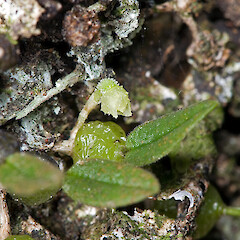Bulbophyllum pygmaeum
Common name
pygmy tree orchid, bulbophyllum
Synonyms
Ichthyostomum pygmaeum (Sm.) D.L.Jones, M.A.Clem. et Molloy
Family
Orchidaceae
Flora category
Vascular – Native
Endemic taxon
Yes
Endemic genus
Yes
Endemic family
No
Structural class
Orchids
NVS code
The National Vegetation Survey (NVS) Databank is a physical archive and electronic databank containing records of over 94,000 vegetation survey plots - including data from over 19,000 permanent plots. NVS maintains a standard set of species code abbreviations that correspond to standard scientific plant names from the Ngä Tipu o Aotearoa - New Zealand Plants database.
ICHPYG
Chromosome number
2n = 38
Current conservation status
The conservation status of all known New Zealand vascular plant taxa at the rank of species and below were reassessed in 2017 using the New Zealand Threat Classification System (NZTCS) – more information about this can be found on the NZTCS website. This report includes a statistical summary and brief notes on changes since 2012 and replaces all previous NZTCS lists for vascular plants.
Please note, threat classifications are often suggested by authors when publications fall between NZTCS assessment periods – an interim threat classification status has not been assessed by the NZTCS panel.
- Conservation status of New Zealand indigenous vascular plants, 2017 . 2018. Peter J. de Lange, Jeremy R. Rolfe, John W. Barkla, Shannel P. Courtney, Paul D. Champion, Leon R. Perrie, Sarah M. Beadel, Kerry A. Ford, Ilse Breitwieser, Ines Schönberger, Rowan Hindmarsh-Walls, Peter B. Heenan and Kate Ladley. Department of Conservation. Source: NZTCS and licensed by DOC for reuse under the Creative Commons Attribution 4.0 International licence.
2017 | Not Threatened
Previous conservation statuses
2012 | Not Threatened
2009 | Not Threatened
2004 | Not Threatened
Distribution
Endemic. New Zealand: Manawatāwhi / Three Kings Islands, North Island, South Island, Stewart Island/Rakiura.
Habitat
Coastal to montane. Mostly epiphytic on forest tree trunks and branches, sometimes on fallen logs, and found as a also rupestral on rocks, cliff faces or banks.
Detailed description
Epiphytic or rupestral, rhizomatous, perennial forming widely spreading or diffuse mats up to 200 mm or more in diameter. Rhizomes heavily branched and intertwined, vermiform, pale pink to white, more or less fleshy, spongy; roots numerous slightly finer than rhizomes otherwise every similar. Pseudobulbs 3–5 mm diameter, green, bright green to pale green, globose, rugose, becoming deeply furrowed and wrinkled with age; each bearing a single leaf arising from the top within a somewhat prominent circular rim. Leaf subsessile to shortly petiolate up to 1.5 mm long; lamina 4–10 × 2–4 mm, dark green to green (rarely reddish green), oblong-ovate to almost orbicular, apex obtuse, upper surface minutely scabrid; undersides prominently keeled. Flower solitary, located on the terminus of a greenish valvate capsule comprising the ovary; peduncle arising from base of pseudobulb, up to 2.5–3.5 mm long at flowering, usually elongating in fruit. Floral bract 1–(2), campanulate-tubular to funneliform, membranous, hyaline or pale white. Pedicel very short (0.5–0.7 mm long), coarsely hirsute; ovary ovoid-ellipsoid, coarsely hirsute, splitting lengthwise at dehiscence. Perianth 1.5–2.0 mm long, white. Sepals minutely hairy, dorsal sepal shorter than lateral sepals. Petals broad, almost meeting behind column. Labellum ovate-oblong, obtuse, more or less thickened, roofing over pouch formed by lateral sepals and column foot. Column barely as long as its foot; wing not exceeding anther.
Manaaki Whenua Online Interactive Key
Similar taxa
Bulbophyllum pygmaeum could be confused with B. tuberculatum but that species has a less diffuse, more compact growth habit; much larger dark green to maroon green, erect, ovoid to ovoid-ellipsoid pseudobulbs; larger and longer, linear-oblong leaves (up to 50 × 5 mm), usually more than one flower; and flowers that have orange to red labella, and white or pale cream petals and sepals. The leaves and ovary of B. tuberculatum lack the minute, coarse hairs that are a feature of B. pygmaeum. The ovary of B. tuberculatum does not at maturity split to become valvate, nor does it retain the flower remnants on the uppermost valve.
Flowering
December–January
Flower colours
White
Fruiting
January–May
Life cycle
Minute seeds are wind dispersed (Thorsen et al., 2009).
Propagation technique
Easily grown in a hanging basket in standard orchid mix. Often can be strapped to a tree trunk and provided it is kept moist during the drier months it grows readily. This species does best in semi-shade. Should not be removed from the wild.
Etymology
pygmaeum: Pigmy
Where To Buy
Not commercially available.
Taxonomic notes
The generic distinction of Ichthyostomum from Bulbophyllum was always considered unclear and many botanists did not accept the division. Recently Australian orchidologists have rejected this genus and returned to a broader circumscription of Bulbophyllum (P. Weston pers. comm. 2014). This view is accepted here.
Attribution
Fact Sheet prepared for NZPCN by P.J. de Lange 14 April 2007. Description adapted from Moore & Edgar (1970).
References and further reading
Moore LB, Edgar E. 1970. Flora of New Zealand, Volume II. Indigenous Tracheophyta: Monocotyledones except Gramineae. Government Printer, Wellington, NZ. 354 p.
Thorsen MJ, Dickinson KJM, Seddon PJ. 2009. Seed dispersal systems in the New Zealand flora. Perspectives in Plant Ecology, Evolution and Systematics 11: 285–309. https://doi.org/10.1016/j.ppees.2009.06.001.
NZPCN Fact Sheet citation
Please cite as: de Lange, P.J. (Year at time of access): Bulbophyllum pygmaeum Fact Sheet (content continuously updated). New Zealand Plant Conservation Network. https://www.nzpcn.org.nz/flora/species/bulbophyllum-pygmaeum/ (Date website was queried)
















